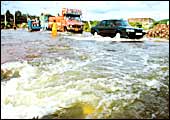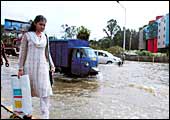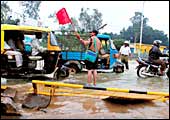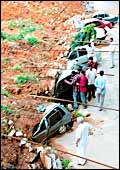 |
|
|
| Watershed: The boundary
wall of an apartment building caves in, while the road above
turns into a waterway |
BANGALORE
Monday October 24, Tuesday October 25, Wednesday October 26
I
wake up to a flooded Bangalore. The rain began to fall on Saturday
morning, just over 36 hours after Infosys Chairman and Chief Mentor
N.R. Narayana Murthy resigned as chairman of the Bangalore International
Airport Limited following a spat of sorts with Janata Dal (S)
leader and former Prime Minister H.D. Deve Gowda, who calls the
shots in the JD(S)-Congress alliance that rules the state of Karnataka
and has turned a blind eye to the infrastructural requirements
of a city that is spoken of as Asia's it-hub in corner rooms in
California. The ostensible reason for this is the loss former
Chief Minister S.M. Krishna's Congress Party suffered in the 2004
elections, forcing it to form a coalition government with the
JD(S). The loss, one school of thought goes, was because Krishna
focussed his energies on Bangalore to the exclusion of all else.
Other reasons for the alliance's apathy to Bangalore's infrastructure
range from Deve Gowda's long-running battle with Krishna and his
alleged hatred for Infosys Technologies, Bangalore's best-known
technology firm whose leadership was perceived as being close
to the former Chief Minister to conspiracy theories about Infosys'
Murthy speaking slightingly of Gowda at a public meeting.
Naïve souls may have felt the heavens
had opened up as a sign of protest; not this reporter (to be a
good one you have to be fashionably cynical). The rain intensified
on Sunday; by that evening most parts of Bangalore were flooded.
Monday morning, and the rain shows no sign of letting up. Most
it companies in the city were closed over the weekend; I wonder
what they will do today (I wonder about this at two levels; a
generic one, and a specific one; I have a meeting scheduled at
Infosys' campus in Electronics City).
A few hours later, and the meeting has been
cancelled. Driving is almost impossible. So, I wade through knee-deep
water praying as I do that my feet don't discover a manhole or
encounter something wriggly that has been displaced because of
the rains and snare an auto-rickshaw. I want to go to Hosur Road,
specifically the Silk Board junction near it, through which some
50,000 software pros pass every day. Five roads intersect at this
junction, as does a flyover that seems to end just at the wrong
spot and, the place is usually gridlocked with 17,000 passenger
car units that ferry everyone from call centre employees and code
jocks to machine operators and textile workers.
 |
 |
| Pitfalls: Cops steer vehicles
clear of manholes, while the otherwise busy Silk Board Junction
(above) is awash |
We don't make it there. A harried traffic
policeman blocks our way and says there is enough traffic already
piled up at the junction. He's right; the road is flooded with
rainwater, sewage, and assorted muck of the sort that rises to
the surface every time it rains heavily. The only vehicles that
can ford this stretch are buses and SUVs; then, that's if they
can get through traffic (some cars spend around five hours at
the spot). I wade through knee-deep water for a closer look (indeed,
wading through knee-deep water is one of my themes for the day)
and discover that watching vehicles attempt the 'great crossing'
had become something of a spectator sport, with passers-by taking
up vantage positions on the flyover or on adjoining buildings
to get a ringside view of the chaos.
Swaminathan Krishnan, Chief Marketing Officer
at Sasken, later tells me that just 40 people managed to make
it to the company's facility on Hosur Road (of a total strength
of 150 at this location). Nandan Nilekani, CEO, Infosys, decides
to work out of the company's office in the tony borough (you wouldn't
describe it so if you see the state of roads there) of Koramangala
after he finds all roads leading to the company's campus in Electronics
City packed with traffic. Call centres find their shifts delayed;
companies like Wipro, Aztec and Datacons find some of their facilities
flooded (Aztec's CEO V. Chandrasekharan tells me that the company
has had to source food and water from its other facilities for
those employees who managed to make it to the campus, only to
be stranded there). At Bidadi, on Bangalore's outskirts, Japanese
carmaker Toyota finds its shift delayed by at least 30 minutes
as workers end up taking a roundabout way to the factory.
For a city that has seen its population almost
double over the last decade to over 7.2 million today, Bangalore's
supporting infrastructure has failed to keep pace. A fellow journalist
calls me up to tell me that cm Dharam Singh's cavalcade has had
to give the flooded locality of Bommasandra a miss after beleaguered
residents blocked the road to get his attention about their locality's
woes. It is unlikely that their measures are going to have much
effect. "You bet the city's reputation around the world's
been affected by all this," says Nilekani.
P.S: On Wednesday, Gowda addresses a meeting
of it honchos, BangaloreIT.in, and tells them that since Bangalore
is choked, everyone should look at Hassan (his home-town) and
other smaller towns in Karnataka. Actually, they'll look without.
|







